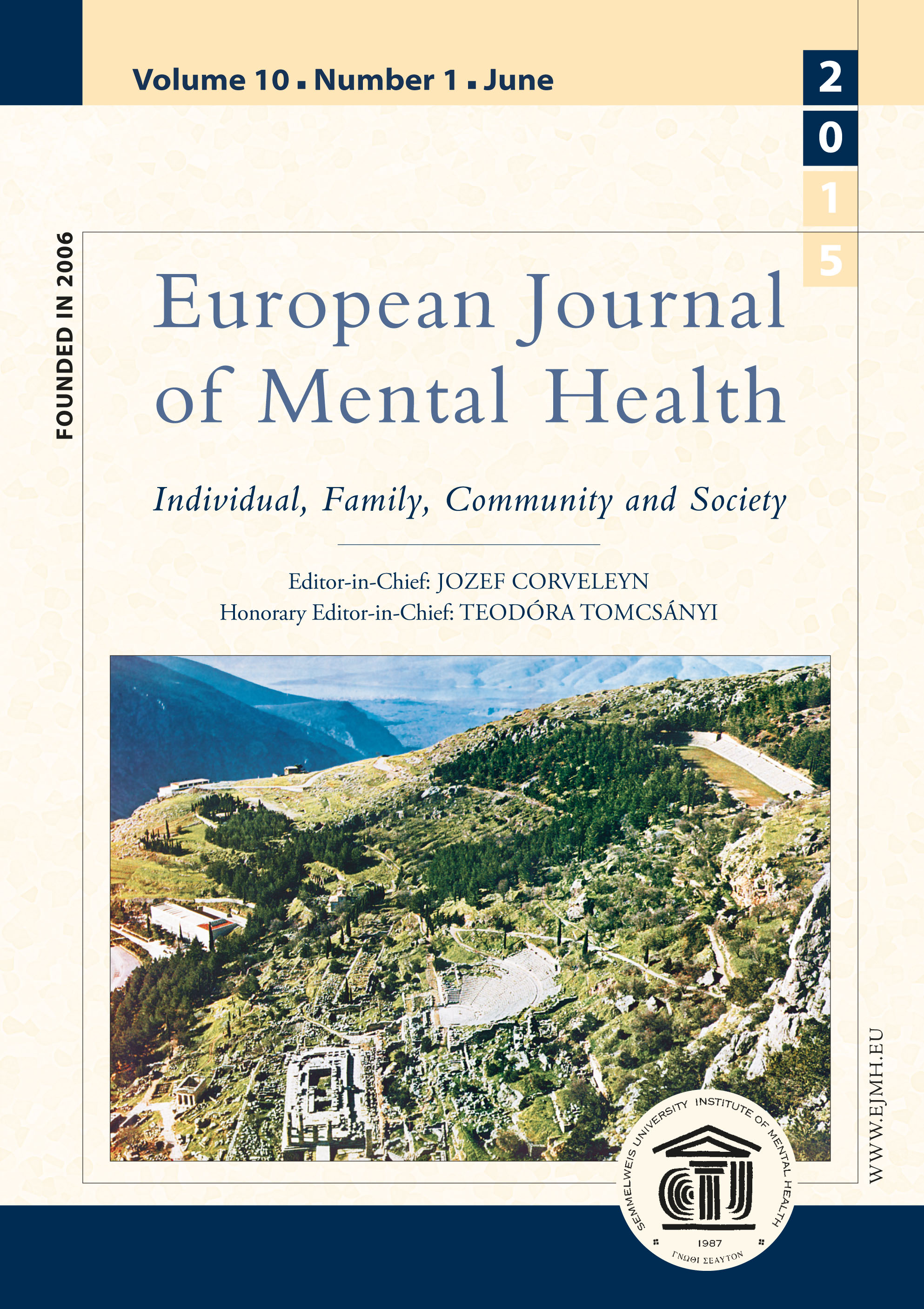
We kindly inform you that, as long as the subject affiliation of our 300.000+ articles is in progress, you might get unsufficient or no results on your third level or second level search. In this case, please broaden your search criteria.


Adolescents’ health behaviours are influenced by many social variables. Among these factors, competitiveness may also have an important role. However, the relationship between competitiveness and health behaviours is a less investigated field of research. Our data were collected in 2005, in the Southern Plain region of Hungary. 548 questionnaires were analysed (age range: 14 to 21 years; M = 16.3 years; SD = 1.3 years; response rate: 91.3%; 42% female). Self-administered questionnaires were used for data collection. Our findings pointed out that competitiveness was in significant relationship with both health risk and preventive health behaviours as previous studies had suggested. We identified three independent dimensions of competitiveness using factor analysis, namely: ‘Enjoyment of competition’; ‘Avoidance of social conflict’, and ‘Fear of competition’. These factors were found to have different roles in varying health behaviours. In contrast with previous studies, we pointed out that health risk behaviours were more frequent among respondents characterised by ‘Avoidance of social conflict’ and ‘Fear of competition’. In terms of preventive health behaviours, we pointed out that physical activity was in significant relationship with every competitiveness dimension. On the other hand, diet control and oral hygiene were associated only with the ‘Avoidance of social conflict’ and ‘Fear of competition’ factors.Based on these results we may conclude that students with a tendency towards social conflict avoidance and fear of competition would be an important target group for health promotion programs.
More...
Tinnitus is the perception of sound in the absence of an external source. Most cases of tinnitus are associated with hearing loss expressed either in the audiogram or detected by more sensitive measures. The objective of this research was to determine the prevalence, type, and degree of hearing loss in patients with subjective tinnitus and to analyze the quality features and some tinnitus characteristics related to associated hearing loss. We analyzed audiometric, otoscopic findings, and the medical reports of 1,046 patients, 573 males (54.8%) and 473 females (45.2%), aged 19 to 89 years. The patients were examined at the Department of Otorhinolaryngology, City General Hospital “8-September”, Skopje, Republic of Macedonia, during the period from January 2014 to October 2015. For statistical data analysis, we used a chi-square test with a signifi cance level of p<0.05.Most of the patients were males aged 60 to 69 years (13.4%), but there was no signifi cant difference in age and gender distribution (p=0.156). The prevalence of hearing loss among these tinnitus patients was 91.9%. Most of the patients had bilateral sensorineural hearing loss (58.2%), predominantly at high frequencies (p<0.00001), and described their tinnitus as high -pitch whistling. Bilateral tinnitus was the most common manifestation (59.4%), followed by left-sided unilateral tinnitus (22.8%). Acoustic trauma and noise-induced hearing loss were present in 27.8% of all patients with otological conditions. Most of the patients with subjective tinnitus have some degree of hearing loss. Bilateral, high-pitched tinnitus and bilateral sensorineural hearing loss, predominantly at high frequencies, were the most common findings. Acoustic trauma and noise-induced hearing loss were the most common otological conditions, and noise-induced tinnitus was the most common type of tinnitus.
More...
Romania experiences a high prevalence of smoking and an increasing percentage of cessation attempts with limited success. In 2012 Davidson College (USA) and University of Medicine and Pharmacy from Târgu Mureş have launched a fiveyear research on this subject. The project is composed of seven complementary research studies that address a broad range of tobacco concerns specific to Romania. Studies have been conducted on the smoking habits among medical students, children and adolescents, pregnant women, residents in social institutions, and school-based, clinic-based and communitybased prevention and cessation programs have been implemented. The researchers have also analyzed the economic impact of smoking and the impact of secondhand smoke on the quality of air. Our tobacco initiative is expected to contribute to reduce tobacco use and to inform tobacco control legislation.
More...






In this essay I focus on the striking parallels between addicted persons and societies. The escapist consumers of the affluent societies often seek asylum and find relief in substances, behaviours, and gadgets which can help to “suspend reality” for a while. 12 step programs like Alcoholics Anonymous are somehow outcast fellowships that follow a spiritual path to resolve life problems of addicted persons. Recovery after “hitting bottom” will follow similar patterns in case of individuals and societies, along with the reinvention of such values as humility, tradition, and personal sacrifice.
More...


Although addictions have always been a part of our human being, consumer culture plays a decisive role in their proliferation. The BPSS (biopsychosocialspiritual) paradigm seems a feasible approach to understanding this phenomenon, since beyond biochemical mechanisms and psychosocial processes, spiritual needs (e.g. searching for a meaning in life) are also important aspects of the epidemics of addictions. Adolescence is a special period of life in terms of the development of addictions, in which peer groups and other social network have a great impact. We need a positive psychology approach to the prevention of addiction. In prevention programs, we should focus on social skills training and building self-esteem, besides providing the necessary information.
More...
We are witnessing a growing frequency of smartphone addiction. Our paper discusses similarities with mental states included under the headline of “Substance-Related and Addictive Disorders”, in the last edition of the Diagnostic and Statistical Manual of Mental Disorders (DSM-5), published by the American Psychiatric Association. It is argued that the term “smartphone addiction” is somewhat misleading, as different people who present its symptoms can in fact be addicted to various functions provided by smartphones, such as online gaming, or Internet pornography. Neurological foundations of both habit formation and habit extinction, as well as the role of dopamine are also presented. The paper enlists various negative consequences of smartphone addiction, such as mindless presence in everyday activities, anxiety, depression, and a weakening of social bonding, but emphasizes also the possibility of finding an effective therapy, able to free one from addiction.
More...
Both overall health and the quality of life of an individual are closely related to the condition of oral health. Proper absorption of food results from its correct chewing and preliminary digestion in the mouth. This in turn affects optimal body condition. To provide a reliant elderly person with support and care in everyday activities, social skills of the third party are necessary as well as their health activity in terms of meeting those needs of such an individual which are connected with everyday prophylaxis and professional dental care. The latter can be effectively realized in bedside conditions.
More...
This article deals with the role of manganese in biological systems. Manganese constitutes of an important element of most of all living organisms and plays a crucial role in biological systems. The biological function of this element is not completely understood, especially in the case of processes of the nerve cells. It is indispensable for the proper functioning of many enzymes such as manganese catalase and superoxide dismutase. Manganese is an element of the “two faces”, because on the one hand, it is an essential trace element for the proper functioning of the body, but its excess and deficiency can lead to disorders of homeostasis.
More...
Sphingolipids are molecules molecules whose properties have forced scientists to reconsider their views on the metabolic function of lipids. According to its name (the prefix “sphingo” comes from the legendary Sphinx) are the source of many puzzles. The discoveries made in the last three decades have proven their key role in cell signaling and control of cell fate. This review article provides information on the structure and metabolism of chosen sphingolipids. In particular, the review of current knowledge on their importance for the functioning of living organisms and the development of various disorders like cancer and neurodegeneration, has been included.
More...
DNA barcodes are short DNA fragments standardized for accurate and rapid species identification. They are successfully applied in taxonomic identification of new organisms as well as in detecting illegal trade of endangered species and poaching. DNA barcodes are used also in metabarcoding, i.e. identification of whole sets of different species from environmental samples such as water, soil or feces. Combination with the next-generation sequencing technology allows to reconstruct biodiversity in the past (permafrost samples) and describe its current state in any environment. Metabarcoding enables the identification of diet components of the species based on the DNA from its stools. This method is much faster and easier to analyze even the most complex diet, which provides data to the protection of endangered species or facilitates the management of game animals.
More...
Multipotent mesenchymal stromal cells also known as mesenchymal stem cells according to the signal from the damaged tissue have the ability to differentiate into several types of specialized cells forming tissues of mesodermal origin such as bone, cartilage, tendon, skeletal muscle or adipose tissue. This ability of MSC is used in regenerative medicine. For the clinical and experimental purposes in order to increase the amount of MSC their ability to proliferate in vitro is used. The best known source of mesenchymal stem cells is the adipose tissue and bone marrow which is the most common source material used for primary culture. This paper presents the next steps of culturing mesenchymal stem cells in vitro.
More...